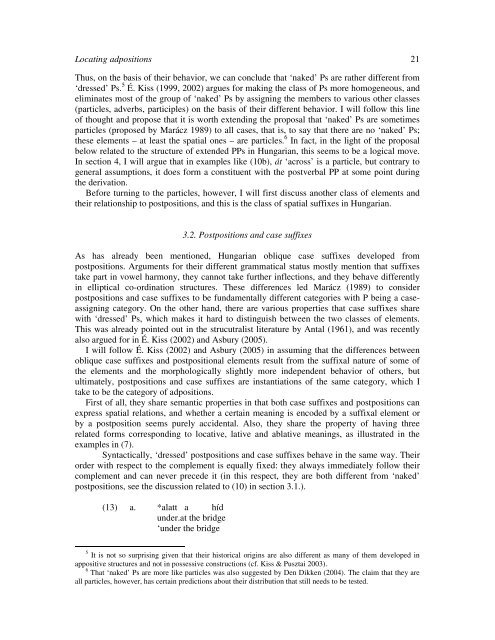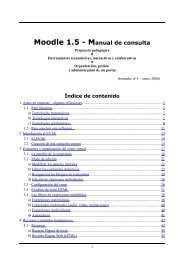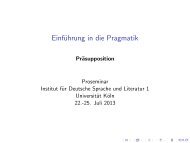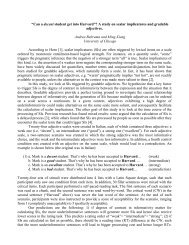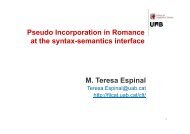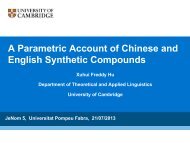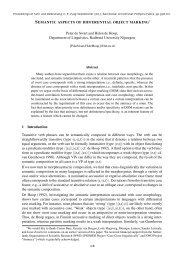Locating adpositions. - corpora@parles.upf
Locating adpositions. - corpora@parles.upf
Locating adpositions. - corpora@parles.upf
Create successful ePaper yourself
Turn your PDF publications into a flip-book with our unique Google optimized e-Paper software.
<strong>Locating</strong> <strong>adpositions</strong> 21<br />
Thus, on the basis of their behavior, we can conclude that ‘naked’ Ps are rather different from<br />
‘dressed’ Ps. 5 É. Kiss (1999, 2002) argues for making the class of Ps more homogeneous, and<br />
eliminates most of the group of ‘naked’ Ps by assigning the members to various other classes<br />
(particles, adverbs, participles) on the basis of their different behavior. I will follow this line<br />
of thought and propose that it is worth extending the proposal that ‘naked’ Ps are sometimes<br />
particles (proposed by Marácz 1989) to all cases, that is, to say that there are no ‘naked’ Ps;<br />
these elements – at least the spatial ones – are particles. 6 In fact, in the light of the proposal<br />
below related to the structure of extended PPs in Hungarian, this seems to be a logical move.<br />
In section 4, I will argue that in examples like (10b), át ‘across’ is a particle, but contrary to<br />
general assumptions, it does form a constituent with the postverbal PP at some point during<br />
the derivation.<br />
Before turning to the particles, however, I will first discuss another class of elements and<br />
their relationship to postpositions, and this is the class of spatial suffixes in Hungarian.<br />
3.2. Postpositions and case suffixes<br />
As has already been mentioned, Hungarian oblique case suffixes developed from<br />
postpositions. Arguments for their different grammatical status mostly mention that suffixes<br />
take part in vowel harmony, they cannot take further inflections, and they behave differently<br />
in elliptical co-ordination structures. These differences led Marácz (1989) to consider<br />
postpositions and case suffixes to be fundamentally different categories with P being a caseassigning<br />
category. On the other hand, there are various properties that case suffixes share<br />
with ‘dressed’ Ps, which makes it hard to distinguish between the two classes of elements.<br />
This was already pointed out in the strucutralist literature by Antal (1961), and was recently<br />
also argued for in É. Kiss (2002) and Asbury (2005).<br />
I will follow É. Kiss (2002) and Asbury (2005) in assuming that the differences between<br />
oblique case suffixes and postpositional elements result from the suffixal nature of some of<br />
the elements and the morphologically slightly more independent behavior of others, but<br />
ultimately, postpositions and case suffixes are instantiations of the same category, which I<br />
take to be the category of <strong>adpositions</strong>.<br />
First of all, they share semantic properties in that both case suffixes and postpositions can<br />
express spatial relations, and whether a certain meaning is encoded by a suffixal element or<br />
by a postposition seems purely accidental. Also, they share the property of having three<br />
related forms corresponding to locative, lative and ablative meanings, as illustrated in the<br />
examples in (7).<br />
Syntactically, ‘dressed’ postpositions and case suffixes behave in the same way. Their<br />
order with respect to the complement is equally fixed: they always immediately follow their<br />
complement and can never precede it (in this respect, they are both different from ‘naked’<br />
postpositions, see the discussion related to (10) in section 3.1.).<br />
(13) a. *alatt a híd<br />
under.at the bridge<br />
‘under the bridge<br />
5 It is not so surprising given that their historical origins are also different as many of them developed in<br />
appositive structures and not in possessive constructions (cf. Kiss & Pusztai 2003).<br />
6 That ‘naked’ Ps are more like particles was also suggested by Den Dikken (2004). The claim that they are<br />
all particles, however, has certain predictions about their distribution that still needs to be tested.


